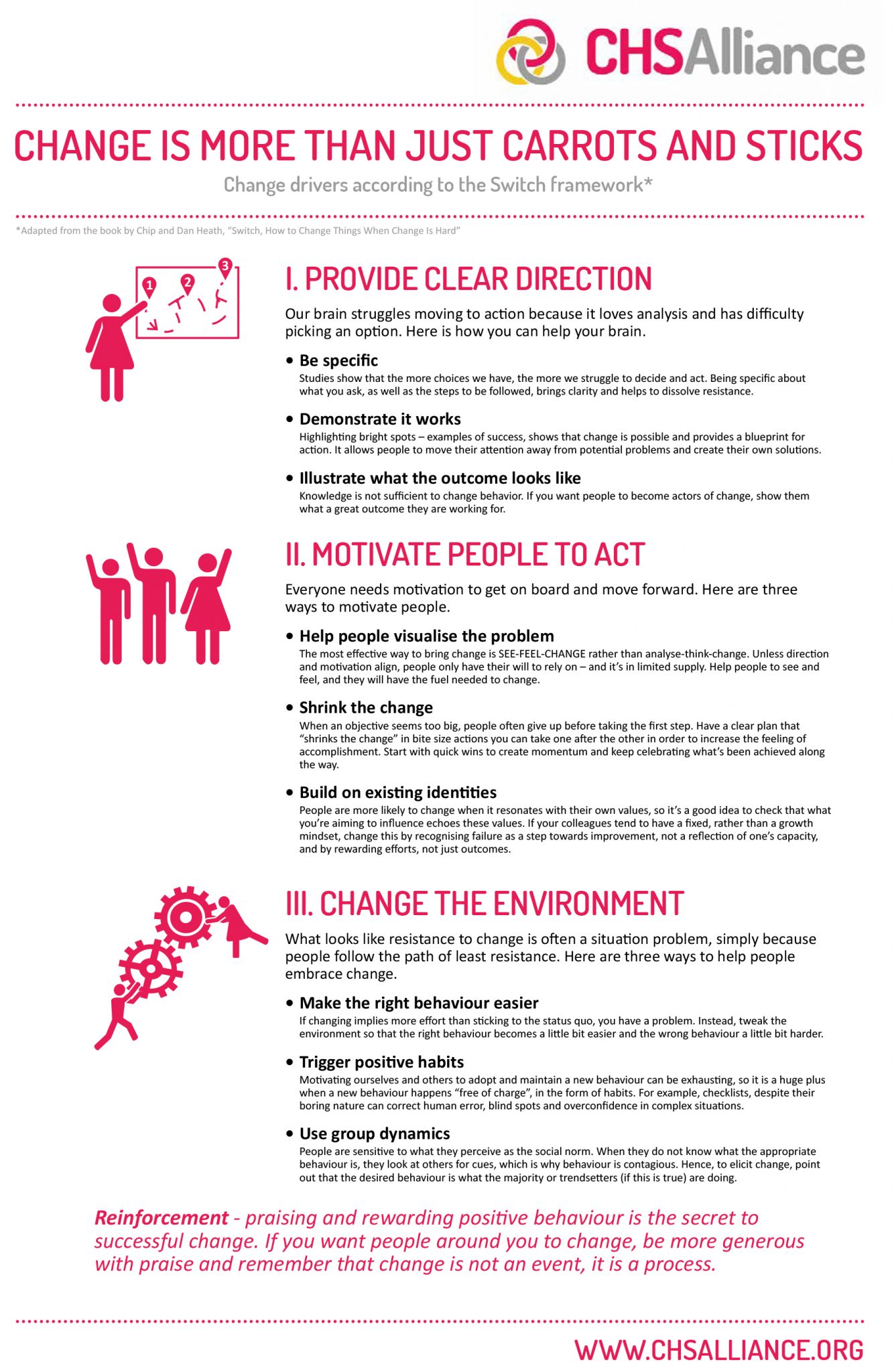Change Is More Than Just Carrots and Sticks
The CHS Alliance was present at this year’s ALNAP conference in Stockholm with a stall. In this blog, David shares his thoughts on the Alliance’s presentation, the adaptation of the change framework provided by Chip and Dan Heath in their book “Switch” to the CHS
When people talk about change, the accepted wisdom seems to be that it’s all about carrots and sticks, meaning how you incentivise change and, if needed, how you force people into adopting change. Either way, there seems to be an agreement that change is something people instinctively resist. If we think about it, however, isn’t this idea simply a reflection of the overall attitude that has guided humanitarian response for many years? Isn’t it a reflection of the way many aid organisations have designed and implemented their programs in the past, telling people they aim to help “We don’t need to talk to you to know what you really need.”
Over the past 10 years or so, the sector has realised that this approach not only didn’t deliver the expected results but also ran counter to the ethos many aid agencies embody in their vision and mission statements. This fact is part of the movement that resulted in the development and adoption of the Core Humanitarian Standard, an approach that aims to make humanitarian response more relevant, effective and accountable.
What would happen if we also turned the way we conceptualise change on its head, challenging policymakers to abandon their current (often top-down) approach to change in favour of a paradigm where change is not taken for granted but rather engineered and designed into a user-friendly, easily actionable process? What if we made sure change initiatives aligned with the values and identities of those who are requested to implement them and made their work easier in the process?
This is the objective we set for ourselves when preparing for the annual ALNAP conference that just took place in Stockholm. After reviewing a number of options, we were seduced by the simplicity, practicality and relevance of the change framework provided by Chip and Dan Heath in their book “Switch”, and decided to adapt it to the CHS for the ALNAP conference.
The authors, using examples from both the nonprofit, public and private sectors argue that for change to be successful, it needs to do three things:
- provide clear direction,
- motivate people to act and
- change the environment.
Their first argument is that our brain struggles to move to action because it loves analysis and finds it difficult to select the best way forward. Indeed, studies have shown that the more choices people have, the more they struggle to take a decision and act. Being specific about a course of action, as well as the steps it comes with brings clarity and can help to dissolve resistance. Similarly, our tendency, influenced by human evolution, drives us to focus on problems rather than solutions. Highlighting examples of success, shows, on the contrary, that change is possible and provides a blueprint for action. It allows people to move attention away from potential problems and create their own solutions. Finally, we can all testify to the fact that knowledge is not sufficient to change behaviour. If we want people to become actors of change, experience shows that illustrating what the expected outcome is, rather than just pointing towards the process helps.
The second argument is quite straightforward: unless you account for people’s emotional side, they will lack the fuel needed to sustain change. In this respect, the most effective way to drive change happens to be “SEE-FEEL-CHANGE” rather than the traditional “analyse-think-change”. It therefore makes a big difference when you find ways to visualise the problem you’re trying to address in order to make it more concrete. A second aspect here relates to our tendency to give up when we lack short-term rewards for our efforts. Indeed, when an objective seems too big, people often give up before even taking the first step. On the other hand, if we start with quick wins to create momentum, shrink the change into bite size actions and celebrate change along the way, we’re more likely to keep people on board. Finally, people are more likely to embrace change when they can clearly see how it resonates with their own values and the way they see their identity.
The third argument directly challenges the assumption that resistance to change is in our DNA and argues that more often than not, resistance to change is simply people following the path of least resistance, something that can be addressed by changing the environment in which people work. If change implies more effort to the status quo, it is seriously compromised. Therefore, tweaking the environment, processes and procedures so that the right behaviour becomes a little bit easier, while the wrong behaviour becomes a little bit harder can make a big difference. Then, anyone who is committed to improving its fitness knows that motivating oneself to adopt and maintain a new behaviour can be exhausting. Therefore, developing habits that support the desired behaviour and make it happen “automatically” can be a huge plus. Finally, people are sensitive to what they perceive to be the social norm. When they don’t know what the appropriate behaviour is, they look at others for cues, which is why behaviour is contagious. Hence, to elicit change, we can point out that the desired practice is what the majority or trendsetters are doing (if it’s true!).
We need however to acknowledge that change is a process, not a three-step formula with predictable results. Reinforcement, the authors of “Switch” say, is the secret to successful change. While our natural tendency is to analyse obstacles or concentrate on what doesn’t work, spending more time praising and reinforcing positive behaviour appears to be the secret to successful, lasting change.


